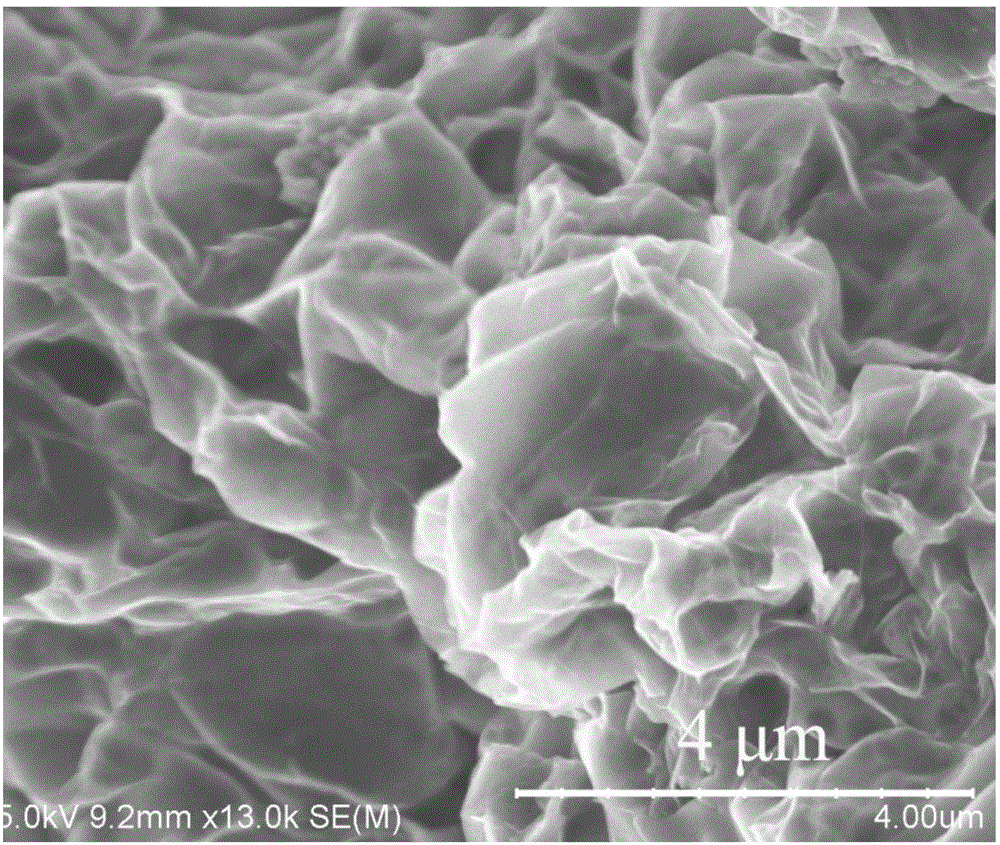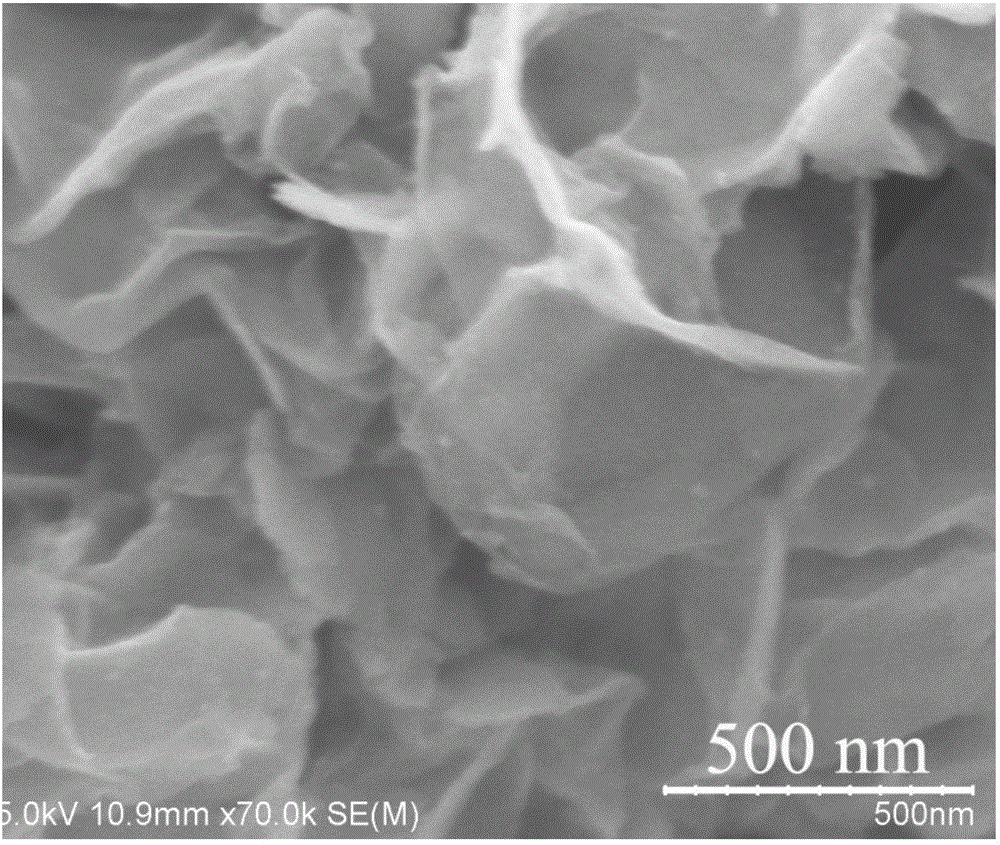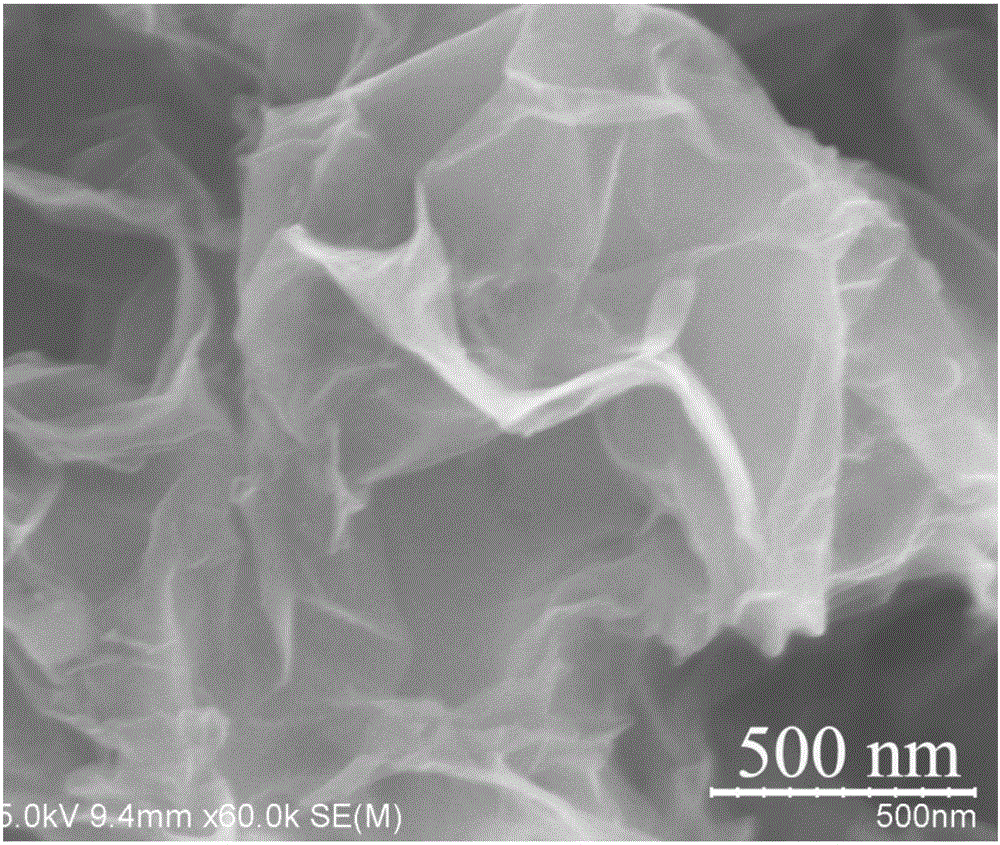Preparation method of manganese sulfide/graphene nano composite material, negative electrode of lithium ion battery and lithium ion battery
A nanocomposite material, lithium-ion battery technology, applied in battery electrodes, nanotechnology, nanotechnology and other directions, can solve problems such as poor cycle stability, achieve stable performance, improve performance, and enhance conductivity.
- Summary
- Abstract
- Description
- Claims
- Application Information
AI Technical Summary
Problems solved by technology
Method used
Image
Examples
Embodiment 1
[0035] Preparation of graphite oxide: weigh 5.0g graphite and 3.75g NaNO respectively 3 Put it into a 1L beaker, stir vigorously, slowly add 150mL of concentrated sulfuric acid, stir for 0.5 hours, then slowly add 20g of KMnO 4 , Added in 0.5 hours, and continued to stir for 20 hours, the viscosity of the reactant increased, and the stirring was stopped to obtain a paste-like purple-red substance. After standing for 5 days, slowly add 500mL deionized water and 30mL H 2 o 2 At this time, the color of the solution becomes more obvious bright yellow. After the solution is fully reacted, it is centrifuged and washed to obtain graphite oxide.
[0036] Hydrothermal process: Dissolve 70mg graphene oxide in 80mL deionized water, add 9mL concentrated sulfuric acid (ρ=1.84g / cm 3 ), ultrasonically dispersed for 3 hours, then transferred to a reactor, and reacted at a constant temperature of 200°C for 20 hours to obtain three-dimensional columnar reduced graphene oxide, which was washe...
Embodiment 2
[0039] The preparation method of graphite oxide is with embodiment 1.
[0040] Hydrothermal process: Dissolve 70mg graphene oxide in 80mL deionized water, add 9mL concentrated sulfuric acid (ρ=1.84g / cm 3 ), ultrasonically dispersed for 3 hours, then transferred to a reactor, and reacted at a constant temperature of 180°C for 20 hours to obtain three-dimensional columnar reduced graphene oxide, which was washed and collected.
[0041]Composite process: Dissolve 0.13g of manganese sulfate and 0.30g of thioacetamide in a mixed solvent (8mL of ethylene glycol and 8mL of isopropanol), add 18mg of three-dimensional columnar reduced graphene oxide to the above solution, soak at 15°C for 2 day, and then transferred to a reactor, 200 ° C constant temperature reaction for 30 hours, the product was washed, vacuum dried at 60 ° C for 4 hours, and the manganese sulfide / graphene composite material was collected.
Embodiment 3
[0043] The preparation method of graphite oxide is with embodiment 1.
[0044] Hydrothermal process: Dissolve 70mg graphene oxide in 80mL deionized water, add 9mL concentrated sulfuric acid (ρ=1.84g / cm 3 ), ultrasonically dispersed for 3 hours, then transferred to a reactor, and reacted at a constant temperature of 160°C for 20 hours to obtain three-dimensional columnar reduced graphene oxide, which was washed and collected.
[0045] Composite process: Dissolve 0.12g of manganese sulfate and 0.30g of thioacetamide in a mixed solvent (8mL of ethylene glycol and 8mL of isopropanol), add 20mg of three-dimensional columnar reduced graphene oxide to the above solution, soak at 35°C for 3 day, then transferred to the reactor, 200 ° C constant temperature reaction for 20 hours, the product was washed, 60 ° C vacuum drying for 6 hours, and the manganese sulfide / graphene composite material was collected.
PUM
| Property | Measurement | Unit |
|---|---|---|
| concentration | aaaaa | aaaaa |
Abstract
Description
Claims
Application Information
 Login to View More
Login to View More - R&D
- Intellectual Property
- Life Sciences
- Materials
- Tech Scout
- Unparalleled Data Quality
- Higher Quality Content
- 60% Fewer Hallucinations
Browse by: Latest US Patents, China's latest patents, Technical Efficacy Thesaurus, Application Domain, Technology Topic, Popular Technical Reports.
© 2025 PatSnap. All rights reserved.Legal|Privacy policy|Modern Slavery Act Transparency Statement|Sitemap|About US| Contact US: help@patsnap.com



